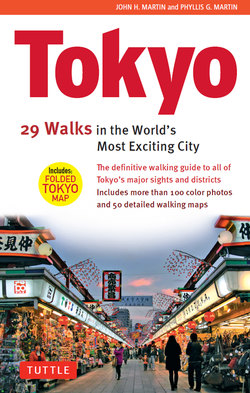Tokyo: 29 Walks in the World's Most Exciting City

Реклама. ООО «ЛитРес», ИНН: 7719571260.
Оглавление
John H. Martin. Tokyo: 29 Walks in the World's Most Exciting City
Отрывок из книги
For Jack, whose untimely passing deprived him of the pleasure of seeing his dedicated scholarship materialize in this wonderful edition. With thanks to the many individuals and institutions, both Japanese and American, who graciously introduced us to Japanese culture and history, beginning in 1968. Those introductions resulted in our enduring love and appreciation of Japan. Special thanks to the Japan National Tourist Association for their help in obtaining additional photos for this book. The authors would further like to acknowledge the Tuttle staff who helped to prepare this book, notably Cal Barksdale, Rob Goss, June Chong, Bambang Ari Setyabudi, Hendro Susetyo, Muh. Fivian Cahyanto, Raharjo, Fajar Wisnu Hardono, Chan Sow Yun and Yukie Ishihara.
JOHN H. MARTIN AND PHYLLIS G. MARTIN
.....
The Hon-maru contained the Audience Hall, the residence, and other official buildings of the reigning shogun. At the southwest corner of the Hon-maru is the previously mentioned Fujimi Yagura, one of three such towers that still exist out of the original 21 that surmounted the castle walls. It was seriously damaged in the 1657 Long Sleeves Fire, but it was reconstructed two years later. At that time the decision was made not to rebuild the rest of the fortifications of the Honmaru, the Nino-maru, and the Sanno-maru. The nation was at peace, and such castles were neither needed nor supportable when faced with the destructive force of modern artillery. Farther along the way is the Fujimi Tamon, the Mt. Fuji Viewing Armory, one of two remaining armories out of the 28 that once existed. Behind this arsenal was a well to supply water to the shogun’s quarters. The well went down almost 100 feet (30 meters).
There were three main groups of buildings in this innermost complex of the Hon-maru site. Closest to the Fujimi Tower in an area now covered by a lawn was a group that contained the Halls for Affairs of State, the shogun’s Audience Hall, and the Ohiroma, the Hall of One Thousand Mats (referring to tatami mats). It was in this grand hall that on the first and fifteenth of each month the shogun received his feudal lords. It was here also that the Dutch from the trading station of Dejima in Nagasaki were required to make the journey every four years to do obeisance to the shogun, to bring gifts, and to demonstrate the foolish ways of the Southern Barbarians—the uncouth Europeans who were best kept at a distance. A second group of buildings contained the shogun’s private residence. A third group of structures consisted of the innermost quarters, which were adjacent to the Central Keep itself. Here were the shogun’s sequestered halls for the women of his court, perhaps some five hundred to one thousand women consisting of his wives, his concubines, the ladies in waiting, attendants, servants, and cooks.
.....